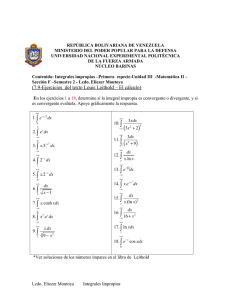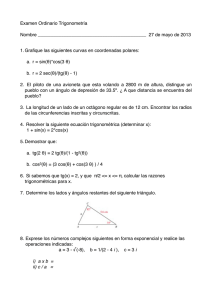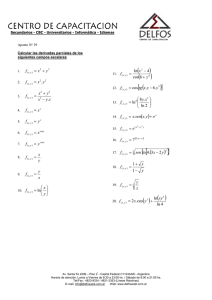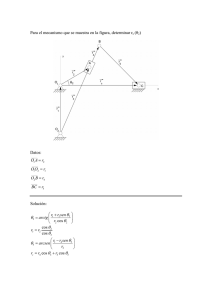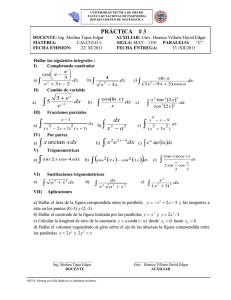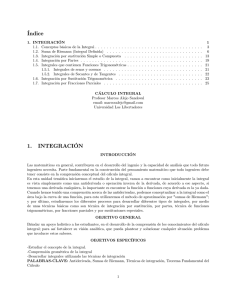Chapter 1 Cálculo integral
Anuncio
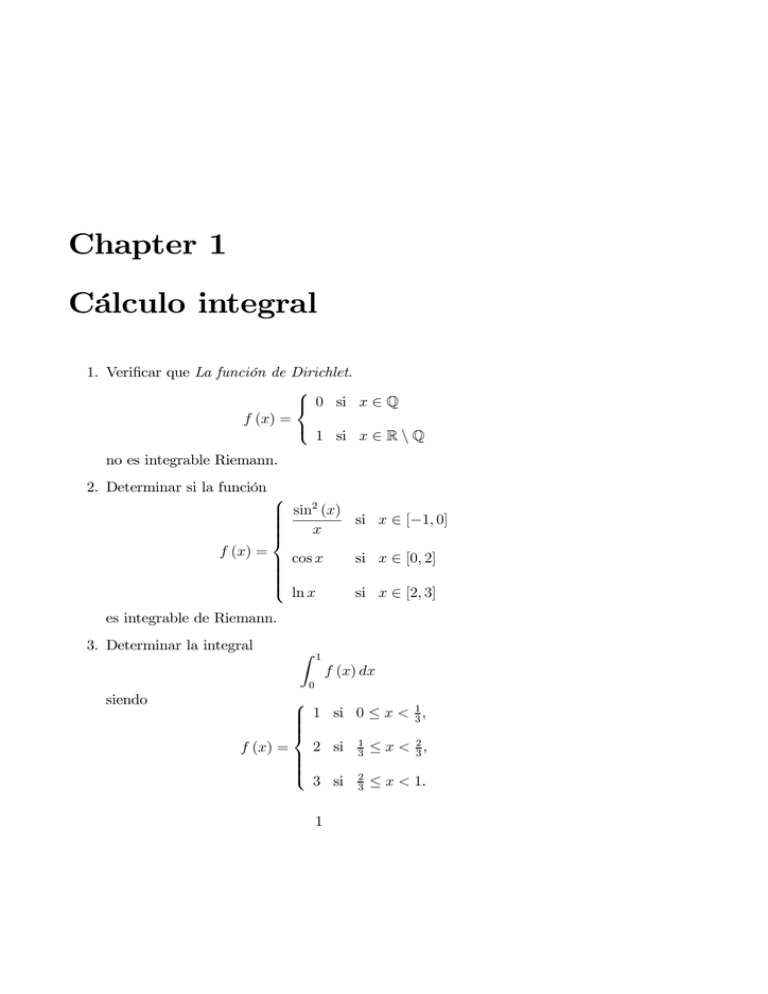
Chapter 1 Cálculo integral 1. Verificar que La función de Dirichlet. 0 si x ∈ Q f (x) = 1 si x ∈ R \ Q no es integrable Riemann. 2. Determinar si la función f (x) = sin2 (x) si x ∈ [−1, 0] x cos x ln x si x ∈ [0, 2] si x ∈ [2, 3] es integrable de Riemann. 3. Determinar la integral Z 1 f (x) dx 0 siendo 1 si 0 ≤ x < 13 , 2 si 13 ≤ x < 23 , f (x) = 3 si 23 ≤ x < 1. 1 2 CHAPTER 1. CÁLCULO INTEGRAL 4. Consideremos la función f (x) = Determinar 1 si 0 ≤ x ≤ 1, 2 si 1 < x ≤ 2. F (x) = Z x f (s) ds 0 para todo x ∈ [0, 2]. 5. Calcular Z x + 1 si −1 ≤ x < 0, 1 si x = 0 f (x) = 2 2 x si 0 < x ≤ 1 6. Evaluar Z 1 −1 7. Calcular: (a) lim Z x−→0 x−→0 f (x) dx −1 siendo (b) lim 1 Z x . x 0 1 dt 1+t2 x2 t2 dt 0 . 4 8. Hallar F 0 (x) siendo (a) F (x) = (b) F (x) = Z Z x+1 t3 dt. 0 x2 +1 t2 dt. −1 |3x + 1| dx. 3 9. Calcular la integral Z b sin xdx 0 utilizando la regla de Barrow. 10. Estudiar, sin resolver la integral, los máximos mínimos, crecimiento y decrecimiento de F (x) para x ≥ 0 en R, que está definida por Z x F (x) = sin t4 dt. 0 INTEGRACIÓN POR DESCOMPOSICIÓN 1. 2. 3. 4. 5. 6. 7. 8. 9. Z (1 + √ √ x)(1 + x − x)dx. Z (x2 + 1)(x2 − 2)x Z x+2 dx. x+1 Z Z Z Z Z Z −2 3 dx. √ √ ( a − x)4 √ dx. ax 2x − 7 dx. x2 + 9 9x2 2x + 3 dx. − 12x + 18 sin2 axdx sin2 x cos3 xdx cos(6x + 7) cos(2x − 5)dx. 4 CHAPTER 1. CÁLCULO INTEGRAL 10. 11. Z Z sin 3x cos 5xdx. x5 − x4 + 2x3 − 7x2 + x − 6 dx. (x − 1)7 INTEGRALES RESOLUBLES POR PARTES 1. 2. 3. 4. 5. 6. Z Z Z Z Z Z √ x 1 + xdx. x2 ln xdx. x2 sin xdx. sin(ln x)dx. x3 e2x dx. 1 arcsin dx. x INTEGRACIÓN POR SUSTITUCIÓN 1. 2. 3. 4. 5. Z Z Z Z Z e √ 3x 2 x3 dx. e4x dx. e4x + 1 tan x1 dx. x2 csc dx. sin 2x √ dx. 3 5 + sin2 x 5 6. 7. 8. 9. 10. 11. 12. 13. 14. 15. 16. 17. 18. 19. 20. Z Z Z Z Z Z Z Z Z Z Z Z Z Z Z 1 1 cos dx. x3 x2 x3 cos(2x4 + 1)dx 32x sin(1 + 32x )dx. 1 √ √ dx. x cos2 x ex 1 dx. cos2 e−x 1 dx. x sin (1 + ln x) 2 x2 √ dx. 1 − x6 1 √ dx. 4 − x2 1 √ dx. −4x − x2 1 √ dx. 20 + 8x − x2 x2 1 dx. +9 1 dx. +9 4x2 ex dx. e2x + 6ex + 10 1 1 √ dx efectuando el cambio de variable x = . t x2 4 + x2 √ sin xdx efectuando el cambio de variable t2 = x. 6 CHAPTER 1. CÁLCULO INTEGRAL 21. 22. 23. 24. 25. 26. 27. Z Z Z Z Z Z Z 1 √ dx efectuando el cambio de variable x = 2 cos t. x2 4 − x2 (ex − 2)ex dx efectuando el cambio de variable ex = t. ex + 1 √ x5 1 − x3 dx efectuando el cambio de variable 1 − x3 = t. ln 2x dx efectuando el cambio de variable ln 2x = t. x ln 4x e2x √ x dx efectuando el cambio de variable ex + 1 = t2 . e +1 xearcsin x √ dx efectuando el cambio de variable arcsin x = t. 1 − x2 1 1 x3 + x2 1+x 1 3 1 dx efectuando el cambio de variable x 6 = t. INTEGRALES RACIONALES 1. 2. 3. 4. 5. 6. Z Z Z Z Z Z x3 x+1 dx. + x2 − 6x x2 + 3x − 4 dx. x2 − 2x − 8 3x + 5 dx. (x + 1)(x − 1)2 4x2 − 5x + 2 dx. (4x2 − 1)(5x − 2) x4 − x3 − x − 1 dx. x3 − x2 1 dx. x(1 + x)2 7 7. 8. 9. 10. 11. 12. Z Z Z Z Z Z 5x2 + 6x + 9 dx. (x − 3)2 (x + 1)2 1 dx. (x2 − 2x + 2)2 12 (x + 1)2 (x2 (x + 1)(x2 + 1)2 dx. 1 + x + 1)2 x3 − 17 dx. (x2 − 4x + 5)2 (x4 1 dx. − 1)2 dx.
